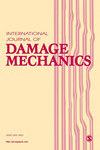Influence of hydrothermal fatigue on mechanical properties and damage mechanisms of hemp-reinforced biocomposites and comparison with glass-reinforced composites
IF 3.9
2区 工程技术
Q2 MATERIALS SCIENCE, MULTIDISCIPLINARY
引用次数: 0
Abstract
The aim of this work was to evaluate the tensile properties and the damage mechanisms of hemp and glass-reinforced composites when they were subjected to hydrothermal fatigue. Each wet/dry cycle consisted in immersing samples in water at 60°C during 12 days and drying them in an oven at 40°C during 2 days. Three different matrices (Epolam, Greenpoxy and Elium) were studied with two reinforcement orientations (±45° and 0°/90°). Gravimetric measurements were performed during 30 wet/dry cycles to determine the evolution of the parameters of the Fick diffusion model. Repeated progressive tensile loading tests instrumented with an acoustic emission setup were also carried out. Damage was investigated by means of SEM and micro-CT. Results showed that hydrothermal fatigue affects significantly the tensile properties of all the composites studied. Hemp/Greenpoxy appears to better resist to hydrothermal fatigue while the hemp/Elium behavior is more impacted. Moreover, contrary to what might be expected, glass/Epolam samples are not the least sensitive to hydrothermal fatigue.水热疲劳对大麻增强生物复合材料机械性能和损伤机理的影响以及与玻璃纤维增强复合材料的比较
这项工作的目的是评估麻类和玻璃纤维增强复合材料在水热疲劳条件下的拉伸性能和损坏机制。每个湿/干循环包括将样品在 60°C 的水中浸泡 12 天,然后在 40°C 的烘箱中干燥 2 天。研究了三种不同的基质(Epolam、Greenpoxy 和 Elium)和两种加固方向(±45° 和 0°/90°)。在 30 个湿/干循环过程中进行了重量测量,以确定 Fick 扩散模型参数的变化情况。此外,还使用声发射装置进行了重复渐进式拉伸加载试验。通过扫描电子显微镜(SEM)和显微计算机断层扫描(Micro-CT)对损坏情况进行了研究。结果表明,水热疲劳对所研究的所有复合材料的拉伸性能都有显著影响。大麻/绿环氧似乎更能抵抗水热疲劳,而大麻/氦的行为受到的影响更大。此外,与预期相反,玻璃/Epolam 样品对热液疲劳的敏感性并不是最低的。
本文章由计算机程序翻译,如有差异,请以英文原文为准。
求助全文
约1分钟内获得全文
求助全文
来源期刊

International Journal of Damage Mechanics
工程技术-材料科学:综合
CiteScore
8.70
自引率
26.20%
发文量
48
审稿时长
5.4 months
期刊介绍:
Featuring original, peer-reviewed papers by leading specialists from around the world, the International Journal of Damage Mechanics covers new developments in the science and engineering of fracture and damage mechanics.
Devoted to the prompt publication of original papers reporting the results of experimental or theoretical work on any aspect of research in the mechanics of fracture and damage assessment, the journal provides an effective mechanism to disseminate information not only within the research community but also between the reseach laboratory and industrial design department.
The journal also promotes and contributes to development of the concept of damage mechanics. This journal is a member of the Committee on Publication Ethics (COPE).
 求助内容:
求助内容: 应助结果提醒方式:
应助结果提醒方式:


